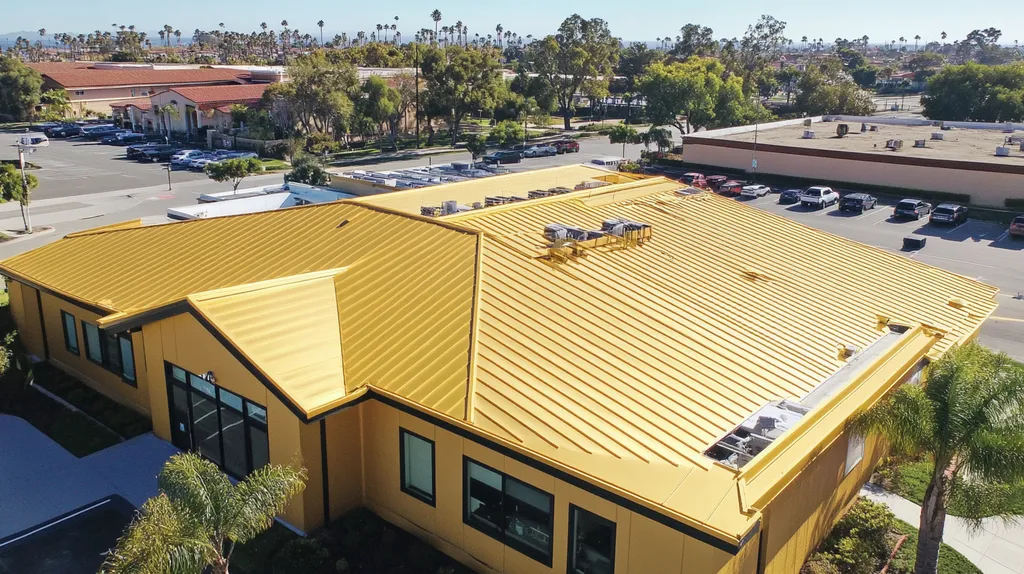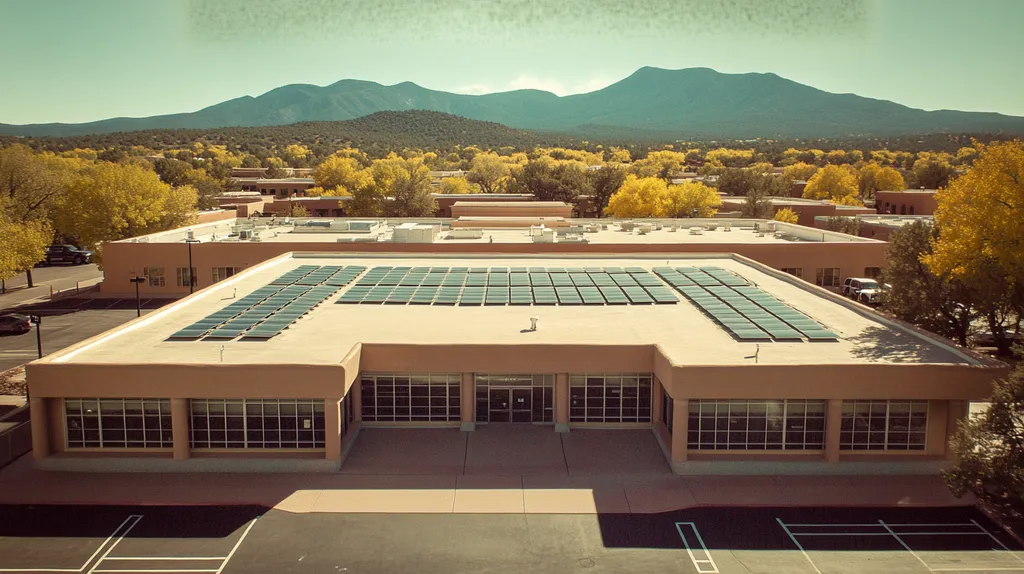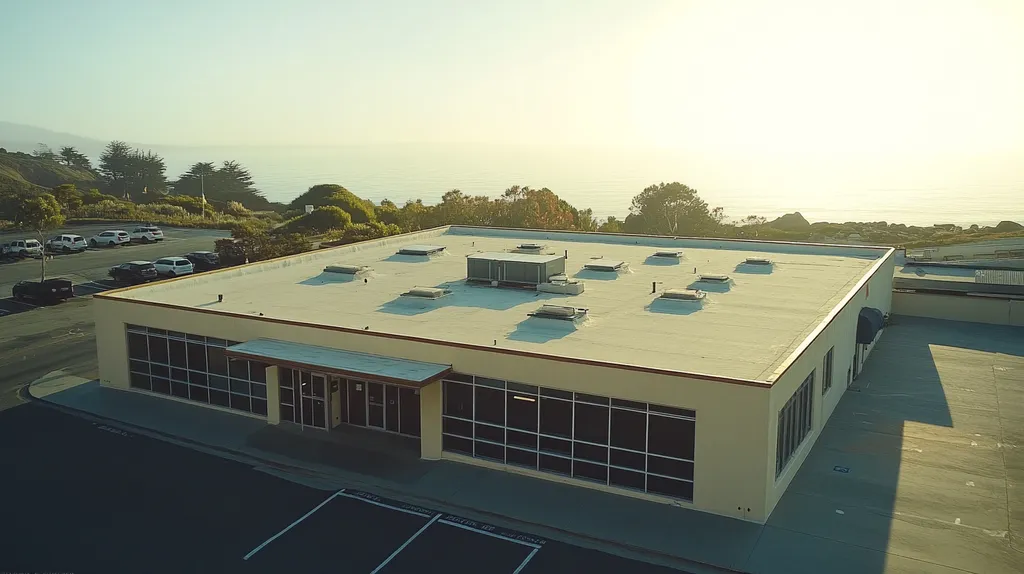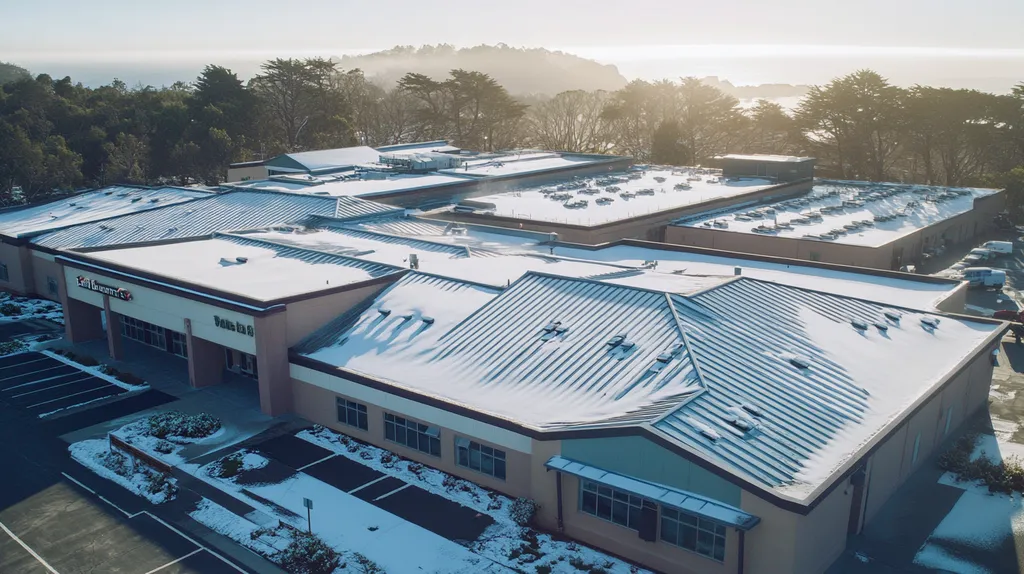Commercial roofing failures cost U.S. businesses over $2.5 billion annually, with 80% of these incidents traced to inadequate inspection practices.
Despite these statistics, many building owners continue to operate under dangerous misconceptions about roof maintenance that put their properties at risk.
From believing inspections are only necessary when damage is visible to assuming all roofing materials require identical maintenance protocols, these myths can lead to catastrophic failures and astronomical repair costs.
This article examines six critical areas where misinformation about commercial roof inspections threatens building integrity, operational continuity, and bottom-line profitability.
SECTION 1: COMMON MISCONCEPTIONS
Commercial property owners often hold misconceptions about roof inspections that can lead to severe consequences. Research indicates that as many as 80% of roofing failures can be traced back to small, neglected issues. Skipping routine inspections not only results in expensive repairs but also disrupts business operations. This section highlights common myths surrounding commercial roof inspections and sheds light on the critical importance of proactive roof maintenance.
Inspections Are Only Necessary When Damage is Visible
A widespread myth suggests that roof inspections are needed only when visible signs of damage emerge. This belief is perilous, as many roofing problems develop unnoticed, lurking beneath the surface. Issues like membrane degradation or structural deterioration can remain hidden until they culminate in leaks or even catastrophic failures.
For example, a flat roof may seem intact from afar, but without regular inspections, water can accumulate, fostering mold and compromising structural integrity. Experts recommend consistent inspections, irrespective of visible damage, to catch these hidden vulnerabilities.
Waiting for noticeable issues often escalates repair costs significantly. Proactive inspections help identify potential problems early, ultimately conserving both time and finances.
Additionally, routine inspections play a vital role in extending a roof’s lifespan. Promptly addressing minor concerns prevents them from escalating into major issues that could jeopardize the entire structure.
Roofs Can Be Inspected Just Once a Year
Another common misconception is that annual inspections suffice for all commercial roofs. However, this isn’t the case. The frequency of inspections should be informed by various factors, including the local climate, roofing type, and surrounding environmental conditions.
For instance, roofs in regions prone to heavy snowfall or frequent storms may benefit from inspections every six months. Seasonal changes can cause roofing materials to expand and contract, leading to cracks or loosened components that require regular oversight.
Moreover, specific roofing materials, such as single-ply membranes, may be more vulnerable to UV damage, necessitating increased vigilance. Ignoring these factors can leave roofs exposed to issues that go undetected for too long.
Ultimately, establishing a customized inspection schedule that considers these variables can help protect a property and improve overall roof performance, reducing the risk of major repairs down the line.
All Roofing Materials Require the Same Inspection Methods
Yet another misconception is that all roofing materials can be inspected using the same techniques. In reality, each roofing material presents unique characteristics that demand tailored inspection strategies.
For example, built-up roofs may need thorough examinations to assess seam integrity, while metal roofs often require scrutiny for rust and corrosion. Overlooking these individualized needs can result in unnoticed problems.
Additionally, effective inspections depend on recognizing the specific vulnerabilities tied to different roofing types. A membrane roof, for instance, may benefit from infrared scanning to detect moisture accumulation, while shingle roofs typically require detailed visual evaluations.
Adapting inspection methods to fit the roofing material is crucial for effective issue detection. A one-size-fits-all approach risks overlooking essential aspects that could undermine the roof’s overall integrity.
SECTION 2: PRACTICAL IMPLICATIONS
Neglecting regular commercial roof inspections can result in dire consequences. Studies reveal that a well-maintained roof can last up to 50% longer than one that is overlooked. For property owners and facility managers, this simple routine translates into significant cost savings, improved safety, and uninterrupted business operations. Recognizing these practical implications empowers decision-makers to protect their building investment effectively.
Impact on Roof Lifespan and Performance
Regular inspections are essential for maximizing the lifespan of a commercial roof. By catching minor issues early, property owners can avoid costly major repairs and maintain the integrity of their roofing system. For example, a small, unnoticed leak can escalate into a major structural problem over time.
Different types of roofing materials have unique requirements that necessitate consistent monitoring. A flat roof, for instance, is especially vulnerable to water pooling, which can lead to leaks and further damage if not monitored properly. Conducting routine inspections allows for quick responses to these potential issues, therefore extending the roof’s lifespan.
Failing to keep up with inspections can create an environment where issues go unnoticed, leading to unforeseen damage that may void warranties and necessitate premature replacements. As a result, property owners miss out on long-term savings and return on investment.
Ultimately, a proactive maintenance strategy not only ensures a roof’s longevity but reinforces the overall value of the property.
Effects on Building Occupants and Operations
The condition of a roof has a direct impact on the working environment for all building occupants. Regular inspections can prevent unexpected leaks or structural failures that disrupt daily operations. For example, a sudden roof leak can damage critical electronic equipment or inventory, leading to downtime and possible financial losses.
Furthermore, roofing issues can compromise indoor air quality. A damaged roof can promote mold growth, posing health risks to employees and visitors. Such problems can lead to decreased productivity and potential liability issues if not addressed promptly.
Inevitably, disregarding roof maintenance can create safety hazards. Structural weaknesses may result in serious accidents, including falls or injuries during maintenance activities. By prioritizing roof inspections, building owners ensure a safer environment for all personnel on-site.
Transparent communication regarding roof condition and maintenance schedules keeps occupants informed, fostering a sense of security and stability. A well-maintained roof leads to higher satisfaction levels for tenants and employees, reducing turnover and attracting new clientele.
Consequences for Maintenance and Repair Schedules
Inadequate inspection schedules often lead to disorganized maintenance plans, resulting in reactive rather than proactive approaches. This creates unpredictable budgets for repairs, causing escalating costs over time. Each unresolved issue can snowball, placing additional strain on maintenance teams and disrupting overall operations.
Additionally, properties that lack routine inspections may face sudden disruptions that require emergency repairs, diverting valuable resources from planned maintenance tasks. Such interruptions can lead to operational inefficiencies and increased stress for facility managers.
Implementing a fixed inspection schedule helps property managers coordinate their maintenance activities systematically. This structured approach ensures that all roofing needs are addressed, promoting cost-effective practices and optimal resource allocation.
Ultimately, consistent roof inspections demonstrate a commitment to the long-term health of infrastructure. This proactive approach enhances operational continuity and aligns seamlessly with organizational goals.
SECTION 3: COST OF MISINFORMATION
The implications of misinformation in commercial roofing are substantial. A single overlooked repair can trigger significant financial consequences. Studies show that postponing necessary maintenance can inflate repair costs by as much as 30%. Property owners must grasp the hidden costs of neglecting roof inspections to safeguard their investments.
Financial Consequences of Delayed Repairs
Ignoring minor roofing issues can lead to substantial repair bills. What begins as a small leak can escalate, causing extensive water damage and threatening a building’s structural integrity. Restoring water-damaged insulation or ceilings can easily amount to thousands of dollars.
Proactive inspections are essential for catching problems early. If a roof begins to fail, the associated costs can escalate rapidly. A leaky roof doesn’t just damage interiors; it can also necessitate a complete roof replacement down the line.
Additionally, owners may face increasing insurance premiums. Insurers often categorize properties with poorly maintained roofs as high-risk, leading to higher operational costs. Neglecting timely action can become an expensive miscalculation.
Ultimately, the cost savings from regular roof inspections far exceed the financial burdens associated with deferred repairs. Investing in preventive maintenance is a crucial measure for protecting financial assets.
Increased Energy Costs Due to Neglect
Neglecting roof inspections can lead to skyrocketing energy bills. Poorly maintained roofs often compromise insulation performance, resulting in energy inefficiencies. According to the Department of Energy, inadequate insulation can result in a loss of up to 30% of energy in commercial buildings.
Reflective roof systems, in particular, may become less effective due to dirt accumulation or physical damage. This can force heating and cooling systems to work harder, ultimately raising utility costs.
Building owners may experience a noticeable spike in monthly energy expenses. Without routine inspections, these costs can double within a year, turning into a serious budgetary concern.
By investing in regular roof inspections, property owners can help mitigate energy losses and ensure their roofs operate at optimum efficiency, which in turn reduces overall costs and enhances tenant comfort.
Potential for Litigation and Warranty Disputes
Neglecting appropriate roof maintenance can result in serious legal consequences. When roofs fail prematurely, property owners may encounter disputes with contractors or face warranty claims. Roofing warranties often stipulate the necessity for regular maintenance; failing to uphold these standards could void the warranty.
Litigation relating to roofing problems is not unusual and can lead to lengthy, expensive court cases. Parties involved may incur significant legal fees, and settlements can run into six figures. Furthermore, reputational damage could have long-lasting effects on a business.
If a roof collapse occurs due to neglect, property owners face severe liability. Injuries stemming from problems with a deteriorating roof can lead to legal action. By prioritizing regular inspections, owners ensure compliance with safety regulations.
In conclusion, the risks linked to misinformation about roof maintenance can lead to dire outcomes. Property owners must focus on accurate information and proactive strategies to avoid disputes and uphold warranties effectively.
SECTION 4: REALITY CHECK
Neglecting commercial roof inspections can have dire consequences, often leading to unexpected repair costs that soar into the thousands. By implementing a proactive inspection strategy, ideally every six months, property owners can significantly reduce long-term expenses and avoid sudden structural failures. In this section, the importance of biannual inspections, the unique needs of various roofing materials, and the role of weather in roof deterioration will be discussed.
The Importance of Biannual Inspections
Commercial roofs endure considerable wear and tear from constant exposure to harsh weather conditions. Conducting inspections every six months helps identify minor issues before they develop into major problems. Early detection can save property owners valuable time and prevent costly repairs.
Routine inspections can uncover potential leaks, damaged flashing, or insulation issues. Promptly addressing these concerns can significantly extend the roof’s lifespan. In contrast, neglecting inspections often leads to unforeseen failures and expensive repair bills.
Property managers should integrate inspection schedules into their maintenance plans. Regular checks ensure that minor issues are addressed and that all roofing system components function properly.
Ultimately, a biannual inspection program is a wise investment for safeguarding the integrity of a building, granting peace of mind to both owners and tenants.
Diverse Roofing Materials and Their Needs
Each roofing system comes with its own set of requirements, making it critical to understand the specific needs of various materials. For example, flat roofs often face unique drainage challenges compared to pitched roofs, which necessitates specialized inspection techniques.
Single-ply membranes like TPO and EPDM need careful monitoring of seams and connections, which can wear over time. Meanwhile, metal roofs are susceptible to rust and damage due to environmental changes. Regular assessments tailored to each roofing type ensure optimal performance.
Overlooking the distinctive characteristics of various roofing materials can lead to missed maintenance opportunities. This oversight can result in accelerated deterioration and costly repairs that could have been easily prevented through focused inspections.
Engaging professionals who are well-versed in the nuances of different roof types is essential. Experienced experts can provide customized recommendations to maximize the lifespan and functionality of each specific material.
The Role of Weather in Roof Deterioration
Weather plays a critical role in a roof’s health and longevity, making it essential to understand its effects. Extreme temperatures, heavy precipitation, and prolonged sun exposure can hasten the deterioration of roofing materials.
For instance, extreme heat may cause roofing membranes to crack, while freezing conditions can lead to ice dam formations. These factors emphasize the necessity of seasonal inspections to verify roof integrity after severe weather events.
Moreover, the building’s location may require tailored inspection and maintenance strategies. Properties situated in storm-prone areas may face unique challenges that necessitate a more aggressive inspection schedule. Local climate conditions should always be taken into account when planning maintenance.
In essence, understanding how weather interacts with roofing materials is key to developing a comprehensive maintenance approach. Regular inspections can help anticipate weather-related issues before they compromise roof performance.
SECTION 5: EVIDENCE-BASED ALTERNATIVES
For commercial property owners, safeguarding their assets through effective roof inspections is more critical than ever. Relying solely on traditional visual assessments can lead to missed underlying issues, resulting in hefty repair costs down the line. Research indicates that implementing preventive measures can reduce emergency roofing expenses by as much as 50%. By exploring evidence-based alternatives, property owners can make informed decisions that enhance roof maintenance and extend its lifespan.
Comprehensive Inspection Checklists
Employing a detailed inspection checklist can significantly enhance the effectiveness of roof assessments. This structured approach ensures that no critical aspect of the roof is overlooked. Items to evaluate include wear and tear, standing water, and indications of leaks.
A tailored checklist empowers property owners to track the performance of their roofs over time, aiding in the early identification of troubling patterns. This proactive methodology not only prolongs the roof’s lifespan but also facilitates effective budgeting for upcoming repairs.
Moreover, comprehensive checklists provide transparency for all stakeholders involved in the decision-making process. Documenting inspection protocols enables property owners to make informed decisions based on actionable data, and fosters improved communication with roofing professionals.
As a result, implementing these checklists allows property owners to prioritize maintenance strategies effectively, thereby optimizing both the performance and durability of their roofing systems.
Use of Infrared Scans and Laboratory Analysis
Infrared scanning technology offers a sophisticated, non-invasive means of detecting concealed moisture within roofing systems. By capturing heat signatures, this advanced method highlights areas where moisture could threaten the roof’s integrity. Without these insights, property owners risk overlooking critical issues that could lead to severe structural damage.
Enhancing the evaluations with laboratory analysis of roofing material samples further refines the inspection process. Testing these materials can uncover chemical vulnerabilities or structural weaknesses, providing clarity on the roof’s lifespan and guiding targeted preventive actions.
The combination of infrared scans and laboratory testing maximizes the likelihood of identifying problems early, aligning with a proactive maintenance strategy. This approach ultimately safeguards investments while promoting the safety and reliability of the building.
In essence, these advanced tools shift the focus from reactive repairs to informed, data-driven decisions that extend the roof’s lifespan and mitigate long-term costs.
Benefits of Intelligent Rooftop Monitoring Systems
Integrating intelligent rooftop monitoring systems can revolutionize how property owners oversee their roofing assets. These smart systems continuously track critical parameters such as temperature fluctuations, moisture levels, and even structural strain. By providing real-time data, these technologies enable timely interventions before minor concerns escalate into significant issues.
Investing in intelligent monitoring can drastically minimize emergency repairs and unexpected downtimes. For example, alerts triggered by unusual moisture levels can prompt timely inspections, protecting both the building’s interior and the owner’s financial interests.
Additionally, these systems generate detailed reports that assist property owners in accurate maintenance budgeting. This level of transparency enhances accountability and supports improved decision-making regarding roofing upgrades or replacements.
By incorporating intelligent monitoring into their roofing strategies, commercial property owners position themselves to mitigate potential risks effectively and make informed choices that foster their financial well-being.
SECTION 6: TEST AND VERIFY
Thorough roof inspections are essential for preventing costly damages and maintaining the integrity of commercial buildings. Engaging poorly qualified inspectors can result in overlooked critical issues, leading to leaks, structural damage, or expensive repairs. Property owners must prioritize hiring certified professionals who adhere to strict safety protocols. This section highlights the importance of confirming inspector qualifications, preparing for inspections, and documenting results for future reference.
Verifying Inspector Qualifications and Experience
Selecting the right roofing inspector is vital for a successful evaluation. Property owners should request credentials, such as certifications from recognized roofing organizations, to ensure expertise. It’s also essential to review an inspector’s experience specific to the type of roof being evaluated.
Checking references and reading online reviews can provide insights into customer satisfaction. An experienced inspector will not only identify existing issues but also anticipate potential future problems. Engaging a qualified inspector fosters peace of mind and informed decisions.
Consider whether the inspector participates in ongoing education; the roofing industry evolves rapidly, and staying informed about the latest materials and technologies is crucial. Qualified inspectors bring valuable insights and suggest long-term management strategies for roofs.
Investing time in verifying qualifications ensures that property owners work with capable professionals. This initial effort can save significant costs and prevent headaches in the long run.
Pre-Inspection Preparation and Safety Protocols
Preparation is key for a safe and efficient roof inspection. Property owners should ensure accessible and organized access to the roof. Removing obstacles, such as equipment or debris, can facilitate a thorough examination.
Adhering to safety protocols is equally important. Inspectors should have the appropriate safety gear, including harnesses, helmets, and goggles. Property owners should verify that the inspector complies with OSHA safety guidelines to minimize accident risks during the evaluation.
Effective communication between building management and inspectors can enhance both safety and efficiency. Property owners should provide inspectors with information about past issues or ongoing concerns related to the roof. This collaboration enables inspectors to target their efforts more effectively.
Ultimately, diligent pre-inspection preparation and adherence to safety protocols help prevent accidents and ensure that the roof’s condition is thoroughly assessed.
Documenting Inspection Results for Future Reference
Consistent documentation of inspection results plays a crucial role in effective roof management. A detailed report should be generated after each inspection, outlining findings and recommendations. This documentation serves as a valuable reference for future evaluations and maintenance planning.
Property owners should ensure that reports include photographs and descriptions of problematic areas. Visual documentation aids in understanding the issues and can help in warranty claims or disputes. Tracking a roof’s condition over time is vital for proactive maintenance.
Maintaining an organized filing system for inspection reports empowers informed decision-making. This practice can aid in scheduling maintenance, budgeting for repairs, and monitoring recurring issues. Organized records enable property owners to act decisively and proactively.
Investing in thorough documentation ultimately benefits the long-term health of the roof, leading to more informed management decisions and extended lifespan.
The Bottom Line
Commercial roof failures cost U.S. businesses billions annually, with 80% of these incidents directly linked to inadequate inspection practices and misguided maintenance beliefs.
The evidence clearly demonstrates that biannual inspections, performed by qualified professionals using advanced diagnostic tools, can extend roof life by up to 50% while preventing catastrophic failures.
Property owners who rely on outdated inspection myths risk not only premature roof failure but also face increased energy costs, voided warranties, and potential litigation.
By implementing comprehensive inspection protocols, utilizing modern monitoring systems, and maintaining detailed documentation, building owners can protect their investments and ensure optimal roof performance for decades to come.
The choice between proactive inspection practices and reactive emergency repairs represents the difference between controlled maintenance costs and unpredictable financial disasters.
FREQUENTLY ASKED QUESTIONS
Q. Are commercial roof inspections only necessary when damage is visible?
A. This is a common myth. Many roofing problems can develop hidden from sight and may lead to severe issues if not addressed promptly. Waiting for visible damage can increase repair costs significantly and reduce the roof’s lifespan. Regular inspections allow for the early detection of potential vulnerabilities, ultimately protecting your investment.
Q. How often should commercial roof inspections be conducted?
A. The frequency of inspections depends on various factors, such as climate, roofing type, and environmental conditions. In general, properties in harsher weather may require inspections every six months. This proactive approach helps catch issues early, enhancing roof performance and longevity.
Q. Do all roofing materials require the same inspection methods?
A. No, each roofing material has unique characteristics that necessitate specific inspection techniques. For example, flat roofs may require checks for membrane integrity, while metal roofs need evaluations for rust. Tailoring inspection methods ensures that all potential issues are identified and addressed efficiently.
Q. What are the financial implications of skipping roof inspections?
A. Neglecting regular inspections can lead to significant financial burdens, as minor issues often escalate into costly repairs. Postponed maintenance can inflate repair costs by as much as 30%, while energy losses can increase operational expenses. Early detection through inspections potentially saves substantial amounts over time.
Q. Why is biannual inspection crucial for commercial roofs?
A. Commercial roofs experience significant wear from harsh weather, making regular inspections essential. Biannual inspections help identify minor issues before they develop into major problems, ensuring timely interventions that extend the roof’s lifespan. This routine maintenance directly impacts overall building integrity and cost efficiency.
Q. How can property owners ensure they hire qualified roofing inspectors?
A. Property owners should request credentials and review the inspector’s experience specific to the roofing type. Checking references and online reviews can provide insights into their expertise. Qualified inspectors often participate in ongoing education, keeping up with the latest roofing materials and technologies essential for thorough evaluations.
Q. What innovative methods can enhance commercial roof inspections?
A. Implementing advanced technologies, such as infrared scans and intelligent monitoring systems, can significantly improve roof inspections. These methods detect hidden issues and provide real-time data on roof conditions, allowing for proactive interventions before small problems escalate into costly repairs, ultimately extending roof lifespan.










